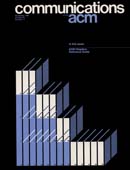November 1981 - Vol. 24 No. 11

Features
Documentation for a model: a hierarchical approach
A set of documents and their organization according to functional requirements in order to produce information that will facilitate the use of models are described. The authors discuss the role of models in the policy process and of documentation in the assessment of such models.
Microcomputers as remote nodes of a distributed system
A time-sharing system may be extended into a general-purpose distributed computing facility through the use of remote microcomputer systems. In such an extension the microcomputer system is not merely a remote terminal but a complete computer system. It becomes part of an integrated network of computers, each with significant local computational power with access to host system data resources. The implementation described emphasizes ease-of-use by minimizing any differences between local and remote data use.
The evolution of user behavior in a computerized conferencing system
Data from 18-month operational trials of the EIES system indicate that the range of features considered valuable in a computer-based communication system increases with the amount of experience gained by using this medium of communication. Simple message systems alone are not likely to satisfy the communications needs of long term, regular users of computerized communications systems. Among the capabilities which long term, regular users find valuable are group conferences, notebooks for text composition, and self-defined commands.
An experimental study of the human/computer interface
An exploratory study was conducted to analyze whether interface and user characteristics affect decision effectiveness and subject behavior in an interactive human/computer problem-solving environment. The dependent variables were performance and the use of the systems options. Two of the independent variables examined, experience and cognitive style, were user characteristics; the other three, dialogue, command, and default types, were interface characteristics. Results indicate that both user and interface characteristics influence the use of the system options and the request for information in the problem-solving task.
Problems in application software maintenance
The problems of application software maintenance in 487 data processing organizations were surveyed. Factor analysis resulted in the identification of six problem factors: user knowledge, programmer effectiveness, product quality, programmer time availability, machine requirements, and system reliability. User knowledge accounted for about 60 percent of the common problem variance, providing new evidence of the importance of the user relationship for system success or failure. Problems of programmer effectiveness and product quality were greater for older and larger systems and where more effort was spent in corrective maintenance. Larger scale data processing environments were significantly associated with greater problems or programmer effectiveness, but with no other problem factor. Product quality was seen as a lesser problem when certain productivity techniques were used in development.
Password authentication with insecure communication
A method of user password authentication is described which is secure even if an intruder can read the system's data, and can tamper with or eavesdrop on the communication between the user and the system. The method assumes a secure one-way encryption function and can be implemented with a microcomputer in the user's terminal.
Authentication of signatures using public key encryption
One of Needham and Schroeder's proposed signature authentication protocols is shown to fail when there is a possibility of compromised keys: this invalidates one of the applications of their technique. A more elaborate mechanism is proposed which does not require a network clock, but does require a third party to the transaction. The latter approach is shown to be reliable in a fairly strong sense.



